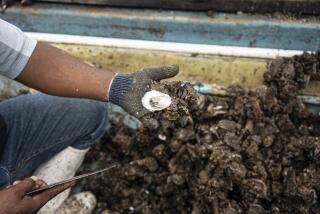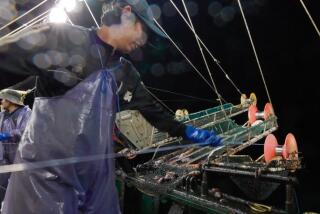The Safest Seafood: Buying, Cooking Tips : Health: A report says that most of the top-selling seafood is safe. Canned tuna has the best record. But some concerns remain.
The National Academy of Sciences, in its “Seafood Safety” report, identified both low- and high-risk seafood varieties.
Most of the best-selling species were called “relatively safe.” But the report did identify some areas of concern.
Shrimp, the most popular seafood in the country, frequently suffers from mishandling either in the store or the home. The National Academy report stated that shrimp are a “relatively safe diet item,” as long as properly refrigerated from the processing plant to the consumer’s kitchen. As an extra precaution, consumers may want to reheat “cooked, ready-to-eat shrimp” to destroy any bacteria or microorganisms that may be present.
Canned tuna, the leading seafood commodity, is “rarely” a cause of food-borne illness unless mishandled by food preparers. In fact, the entire category of canned seafood was described in the report as “among the safest of seafood.”
Even when served fresh, tuna, as a high-seas fish, generally has low levels of environmental contaminants, the National Academy reported. (Species such as cod, pollock and haddock are also considered low in chemical contaminants because they are found in deep offshore waters. Ocean-caught salmon is also relatively free of contaminants but is notorious for hosting parasites and should be fully cooked to destroy worms and other organisms, according to the U.S. Food and Drug Administration.)
But if improperly refrigerated, fresh tuna can accumulate elevated histamine levels that cause scombroid fish poisoning. There have also been instances where mercury was found in fresh tuna, which may be a concern to certain high-risk groups, such as pregnant women, infants and young children.
Processed products--fish sticks, breaded fillets and fish nuggets made from white-fleshed fish such as cod, haddock and pollock-- were said to have a “good” bill of health. The Academy said problems are usually found only when the items are improperly refrigerated or frozen.
The greatest number of illnesses from fin fish come from the tropical or sub tropical species. These warm water fish have been linked to scombroid and ciguatera poisonings. Mahi mahi, fresh tuna and bluefish are considered the most likely to cause scombroid or histamine poisoning. Ciguatera has been most often linked to barracuda, grouper, amberjack and certain tropical snappers. Neither scombroid or ciguatera is destroyed in the cooking process.
Fresh-water fish from certain “hot spots” such as the Great Lakes, Santa Monica Bay, Puget Sound and the Chesapeake Bay also may carry “undesirable levels of chemical contaminants,” according to the National Academy.
Swordfish with elevated mercury levels can be considered a reproductive toxin, one that should be avoided by women considering having children.
Catfish, trout, salmon and other farmed species have a “good” record as far as food-borne disease, the report stated, because they are generally cooked immediately before serving.
The National Academy reported that risks from recreationally caught fish “may be higher than from commercially available seafood.” These tend to be mishandled or from waters with suspect quality. The study recommended that health officials take greater efforts to educate anglers about the dangers of consuming fish from contaminated waters.
The highest risk seafoods are molluskan shellfish--oysters, clams and mussels--eaten raw. Generally the whole animal is consumed including the intestines and viscera, which may accumulate “all possible sources of contamination.” The problem is compounded by the illegal harvest of shellfish from contaminated waters and from imports of unknown quality. “There is always some risk in consuming uncooked whole molluskan shellfish, and this practice--although of long standing--should perhaps be discouraged,” the Academy’s report stated.
Several general precautions, issued by the UC Extension Service’s Sea Grant program, can be taken to greatly reduce the risk of illness from seafood. These include:
* Always purchase fish and shellfish from reputable retailers.
* Select seafood with a fresh, mild odor and without any traces of browning or drying around the edges.
* Purchase raw shellfish carefully. Clams, oysters and mussels in the shell are alive and the shells close tightly when tapped. Gaping shells indicate that the shellfish are dead and not edible.
* Refrigerate live shellfish in well-ventilated containers covered with a damp cloth or paper towels.
* Keep seafood cold. Never let seafood, or any other perishable product, sit for any extended period in a warm environment such as a kitchen counter or a car on a hot day.
* Store fresh, pasteurized or smoked seafood at between 32 degrees and 38 degrees.
* Handle raw and cooked seafood products separately. Thoroughly wash and rinse with hot water knives, containers and cutting boards between handling raw and cooked seafoods.
* Cook fish and shellfish thoroughly or to an internal temperature of 140 degrees.
* Thaw frozen seafood in the refrigerator. Do not thaw at room temperature or under warm running water.
For more detailed seafood handling instructions and brochures write to UC Extension Service’s Sea Grant Program, Department of Food Science, UC Davis, Davis, Calif. 95616.
More to Read
Eat your way across L.A.
Get our weekly Tasting Notes newsletter for reviews, news and more.
You may occasionally receive promotional content from the Los Angeles Times.










